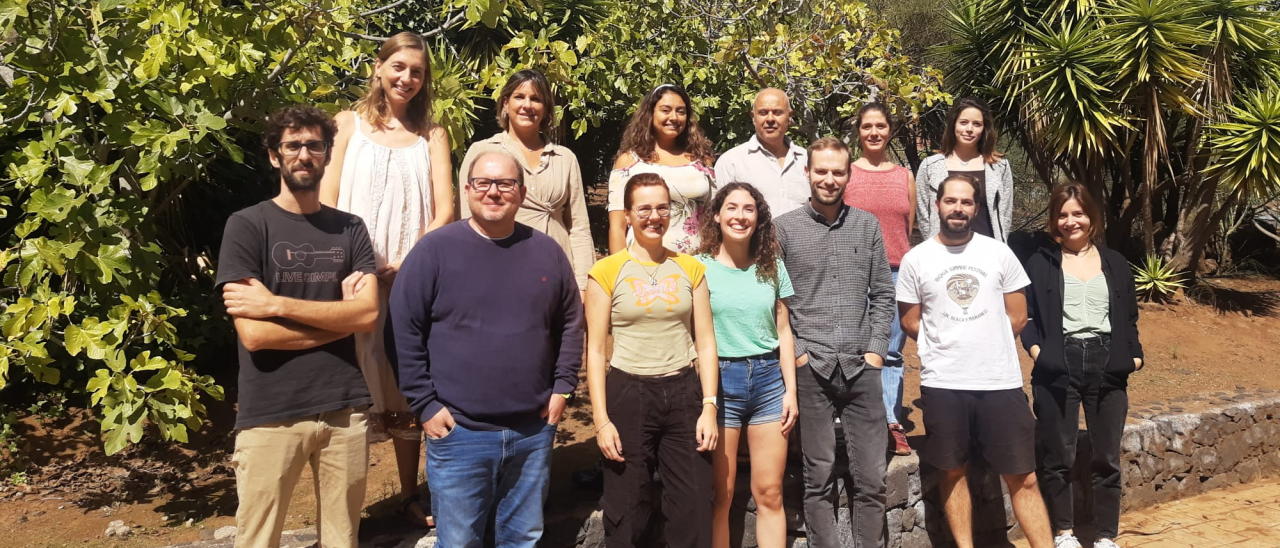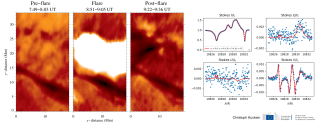Grants related:
General
Welcome to the Traces of Galaxy Formation research group website.
We are a large, diverse, and very active research group aiming to provide a comprehensive picture for the formation of galaxies in the Universe. Rooted in detailed stellar population analysis, we are constantly exploring and developing new tools and ideas to understand how galaxies came to be what we now observe.
A complex star formation history, as the one expected to describe galaxy evolution, needs a multidisciplinary approach to be fully understood. Our group at the IAC consists of experienced researchers in cosmological simulations, dynamical studies, stellar populations and morphological properties of galaxies up to high redshift. We combine different approaches (e.g. observations and theory, secular and cosmological evolution studies) to obtain a complete view of the dominant mechanisms driving the evolution of galaxies.
Within this general framework, we are currently exploring three main areas of research:
- Stellar population synthesis models
- Development of new stellar population synthesis models
- Stellar population analysis tools
- Universality of the stellar initial mass function (IMF)
- Cosmic evolution of galaxies
- Massive galaxy evolution
- Stellar populations in different environments
- Low surface brightness science
- Machine learning and cosmological simulations
- Evolutionary processes in nearby galaxies
- The role of black holes in the evolution of galaxies
- Surveys of nearby galaxies
- Stellar kinematics and dynamical models
If you want to get in contact or work with us, please send an email to the head of the group (Ignacio Martín-Navarro ignacio.martin [at] iac.es (ignacio[dot]martin[at]iac[dot]es)).
Members
Results
Here you can find some of our most recent highlights:
- Local variations of the stellar velocity ellipsoid - II. The effect of the bar in the inner regions of Auriga galaxies. Walo et al. 2022, MNRAS (https://ui.adsabs.harvard.edu/abs/2022MNRAS.513.4587W)
- Anisotropic satellite galaxy quenching modulated by black hole activity. Martín-Navarro et al. 2021, Nature (https://ui.adsabs.harvard.edu/abs/2021Natur.594..187M)
- Evaluating hydrodynamical simulations with green valley galaxies. Angthopo et al. 2021, MNRAS (https://ui.adsabs.harvard.edu/abs/2021MNRAS.502.3685A)
- Sub one per cent mass fractions of young stars in red massive galaxies. Salvador-Rusiñol et al. 2020, Nature Astronomy (https://ui.adsabs.harvard.edu/abs/2020NatAs...4..252S)
- Detection of young stellar populations in apparently quenched low-mass galaxies using red spectral line indices. de Lorenzo-Cáceres et al. 2020, MNRAS (https://ui.adsabs.harvard.edu/abs/2020MNRAS.498.1002D)
Scientific activity
Related publications
-
The long Galactic bar as seen by UKIDSS Galactic plane survey
Context: Over the past decade there have been a series of results supporting the hypothesis of the existence of a long thin bar in the Milky Way with a half-length of 4.5 kpc and a position angle of around 45°. This is apparently a very different structure from the triaxial bulge of the Galaxy, which is thicker and shorter and dominates the star
Cabrera-Lavers, A. et al.Advertised on:
122008 -
The Orientation of Disk Galaxies around Large Cosmic Voids
Using a large sample of galaxies from the the seventh data release of the Sloan Digital Sky Survey (SDSS-DR7), we have analyzed the alignment of disk galaxies around cosmic voids. We have constructed a complete sample of cosmic voids (devoid of galaxies brighter than Mr - 5log h = -20.17) with radii larger than 10 h -1 Mpc up to redshift 0.12. Disk
Varela, J. et al.Advertised on:
12012 -
Probing IGM large-scale flows: warps in galaxies at shells of voids
Context: Hydrodynamical cosmological simulations predict flows of the intergalactic medium along the radial vector of the voids, approximately in the direction of the infall of matter at the early stages of the galaxy formation. Aims: These flows might be detected by analysing the dependence of the warp amplitude on the inclination of the galaxies
López-Corredoira, M. et al.Advertised on:
92008 -
Radial distribution of near-UV flux in disc galaxies in the range 0 ⪉ z ⪉ 1
Context: In the last 8 Gyr of cosmic time the global star formation rate (SFR) has declined by roughly an order of magnitude, and most of this activity has been progressively confined to ever less massive galaxies (“downsizing”). Previous studies show that the main drivers of the decline in the global SFR are the spiral galaxies. However, we still
Azzollini, R. et al.Advertised on:
72009 -
Cosmic Evolution of Stellar Disk Truncations: From z~1 to the Local Universe
We have conducted the largest systematic search so far for stellar disk truncations in disklike galaxies at intermediate redshift (z
Azzollini, R. et al.Advertised on:
92008 -
Color Profiles of Disk Galaxies since z ~ 1: Probing Outer Disk Formation Scenarios
We present deep color profiles for a sample of 415 disk galaxies within the redshift range 0.1
Azzollini, R. et al.Advertised on:
62008 -
Velocity Dispersions and Stellar Populations of the Most Compact and Massive Early-type Galaxies at Redshift ~1
We present Gran-Telescopio-Canarias/OSIRIS optical spectra of four of the most compact and massive early-type galaxies (ETGs) in the Groth Strip Survey at redshift z ~ 1, with effective radii R e = 0.5-2.4 kpc and photometric stellar masses M sstarf = (1.2-4) × 1011 M sun. We find that these galaxies have velocity dispersions σ = 156-236 km s-1
Martinez-Manso, Jesus et al.Advertised on:
92011 -
The relation between stellar populations, structure and environment for dwarf elliptical galaxies from the MAGPOP-ITP
Dwarf galaxies, as the most numerous type of galaxy, offer the potential to study galaxy formation and evolution in detail in the nearby universe. Although they seem to be simple systems at first view, they remain poorly understood. In an attempt to alleviate this situation, the MAGPOP EU Research and Training Network embarked on a study of dwarf
Michielsen, D. et al.Advertised on:
42008 -
The morphologies and masses of extremely red galaxies in the Groth Strip
We present a new catalogue of EROs from the Groth Strip and study the relation between their morphology and mass. With a selection criterion F814W-Ks≥ 4 and Ks≤ 21.0 we find 102 EROs, over a survey area of 155 arcmin2, leading to a surface density of 0.66 arcmin-2. The photometric data include U, B, F606W, F814W, J, Ks bands. Morphologies are based
Hempel, A. et al.Advertised on:
72011 -
The Minor Role of Gas-Rich Major Mergers in the Rise of Intermediate-Mass Early Types at z <= 1
We study the evolution of galaxy structure since z ~ 1 to the present. From a Great Observatories Origins Deep Survey South (GOODS-S) multi-band catalog, we define (blue) luminosity- and mass-weighted samples, limited by MB = 1010 M sun, comprising 1122 and 987 galaxies, respectively. We extract early-type (ET; E/S0/Sa) and late-type (LT; Sb-Irr)
López-Sanjuan, C. et al.Advertised on:
22010 -
The HST/ACS Coma Cluster Survey. VIII. Barred Disk Galaxies in the Core of the Coma Cluster
We use high-resolution (~0farcs1) F814W Advanced Camera for Surveys (ACS) images from the Hubble Space Telescope ACS Treasury survey of the Coma cluster at z ~ 0.02 to study bars in massive disk galaxies (S0s), as well as low-mass dwarf galaxies in the core of the Coma cluster, the densest environment in the nearby universe. Our study helps to
Marinova, Irina et al.Advertised on:
22012 -
The HST/ACS Coma Cluster Survey. IV. Intergalactic Globular Clusters and the Massive Globular Cluster System at the Core of the Coma Galaxy Cluster
Intracluster stellar populations are a natural result of tidal interactions in galaxy clusters. Measuring these populations is difficult, but important for understanding the assembly of the most massive galaxies. The Coma cluster of galaxies is one of the nearest truly massive galaxy clusters and is host to a correspondingly large system of
Peng, Eric W. et al.Advertised on:
32011 -
The HST/ACS Coma Cluster Survey - VI. Colour gradients in giant and dwarf early-type galaxies
Using deep, high-spatial-resolution imaging from the Hubble Space Telescope/Advanced Camera for Surveys (HST/ACS) Coma Cluster Treasury Survey, we determine colour profiles of early-type galaxies in the Coma cluster. From 176 galaxies brighter than MF814W(AB)=-15 mag that are either spectroscopically confirmed members of Coma or identified by eye
den Brok, M. et al.Advertised on:
72011 -
The HST/ACS Coma Cluster Survey - III. Structural parameters of galaxies using single Sérsic fits
We present a catalogue of structural parameters for 8814 galaxies in the 25 fields of the Hubble Space Telescope/ACS Coma Treasury Survey. Parameters from Sérsic fits to the two-dimensional surface brightness distributions are given for all galaxies from our published Coma photometric catalogue with mean effective surface brightness brighter than
Hoyos, Carlos et al.Advertised on:
32011 -
Spectro-photometric close pairs in GOODS-S: major and minor companions of intermediate-mass galaxies
Aims: Recent work has shown that major mergers of disc galaxies can only account for 20% of the growth of the galaxy red sequence between z = 1 and z = 0. Our goal here is to provide merger frequencies that encompass both major and minor mergers, derived from close pair statistics. We aim to show that reliable close pair statistics can be derived
López-Sanjuan, C. et al.Advertised on:
72010 -
On the Connection of the Apparent Proper Motion and the VLBI Structure of Compact Radio Sources
Many of the compact extragalactic radio sources that are used as fiducial points to define the celestial reference frame are known to have proper motions detectable with long-term geodetic/astrometric very long baseline interferometry (VLBI) measurements. These changes can be as high as several hundred microarcseconds per year for certain objects
Moór, A. et al.Advertised on:
62011 -
On the buildup of massive early-type galaxies at z ⪉ 1. I. Reconciling their hierarchical assembly with mass downsizing
Context. Several studies have tried to ascertain whether the increase in abundance of the early-type galaxies (E-S0a's) with time is mainly due to major mergers, but have reached opposite conclusions. Aims: We have tested it directly through semi-analytical modelling, quantifying the possible contribution of the observed major mergers to the
Eliche-Moral, M. C. et al.Advertised on:
92010 -
Color Profiles of Spiral Galaxies: Clues on Outer-Disk Formation Scenarios
We have explored radial color and stellar surface mass density profiles for a sample of 85 late-type spiral galaxies with deep (down to ~27 mag arcsec-2) SDSS g'- and r'-band surface brightness profiles. About 90% of the light profiles have been classified as broken exponentials, exhibiting either truncations (Type II galaxies) or antitruncations
Bakos, Judit et al.Advertised on:
82008 -
Are dry mergers dry, moist or wet?
We present a spectral analysis of a sample of red-sequence galaxies identified by van Dokkum as dry merger remnants and ongoing dry mergers. Kinematics, stellar population absorption features and ionization from emission lines are derived. We find that approximately half of the sample showing strong tidal features have younger stellar populations
Sánchez-Blázquez, P. et al.Advertised on:
122009 -
Constraining the formation of inner bars: photometry, kinematics and stellar populations in NGC 357
Double-barred galaxies are common in the local Universe, with approximately one-third of barred spirals hosting a smaller, inner bar. Nested bars have been proposed as a mechanism to transport gas to the very central regions of the galaxy, trigger star formation and contribute to the growth of the bulge. To test this idea, we perform for the first
de Lorenzo-Cáceres, A. et al.Advertised on:
22012



